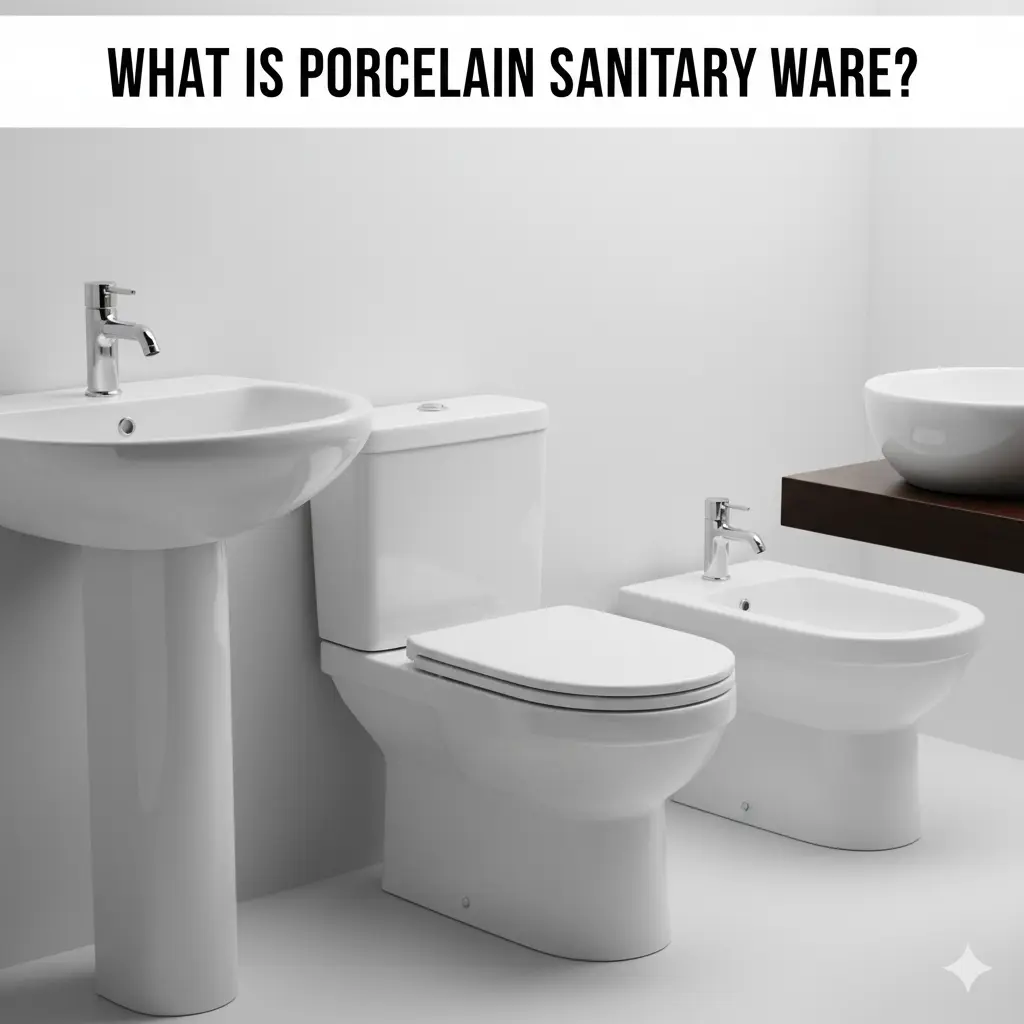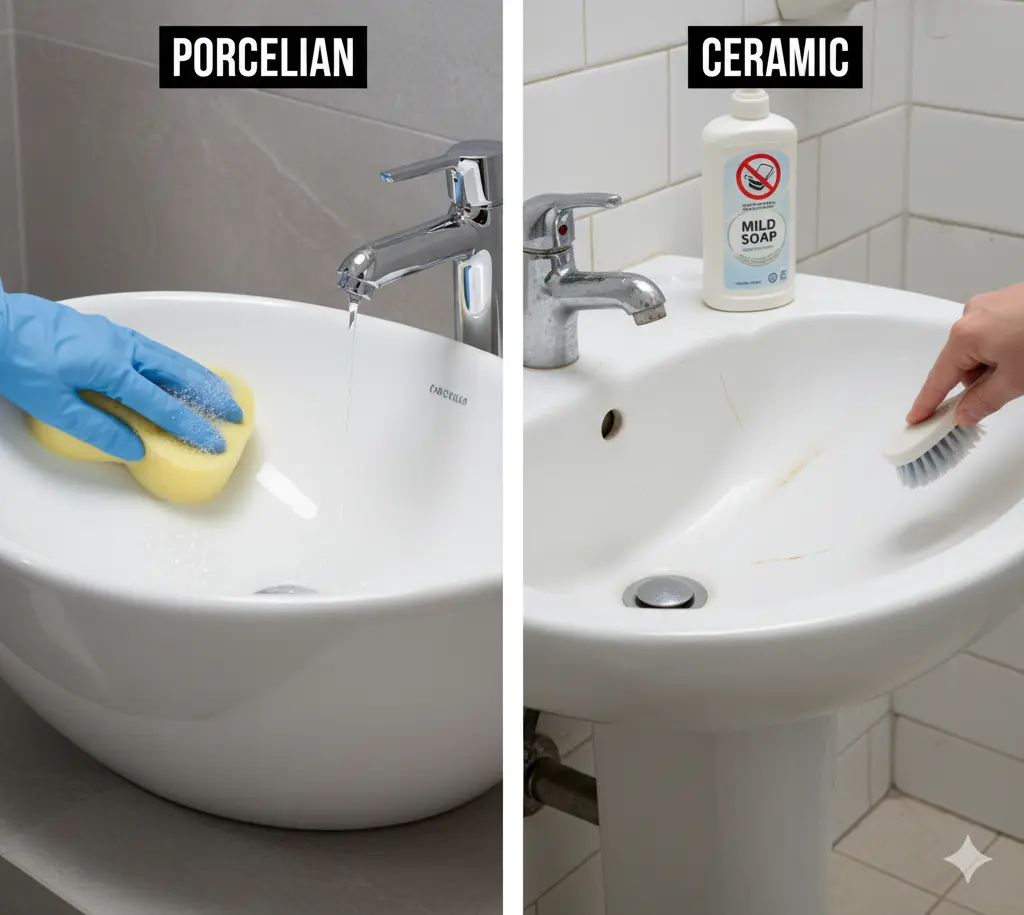
HDPE Monofilament vs Polypropylene Rope: Which Is Better?
05 November, 2025
Connect With Our Team
Designing or renovating a bathroom is more than just choosing stylish tiles and faucets, it’s about creating a space that combines comfort, durability, and hygiene. Among all the essential elements, sanitary ware plays a vital role in defining both functionality and aesthetics. From wash basin sinks to water closet toilets, every fixture adds to the overall personality of the bathroom. But one question often arises: should you choose ceramic sanitaryware or porcelain sanitary ware?
Both materials fall under the category of sanitary ceramic, yet they differ significantly in texture, strength, finish, and cost. Understanding these differences is crucial to selecting the right type for your project, whether it’s a cozy home bathroom, a luxury hotel suite, or a high-traffic commercial restroom.
Ceramic sanitaryware refers to a wide range of products made from a mixture of natural clay, quartz, kaolin, and feldspar. The blend is molded into shapes and fired at high temperatures to achieve a solid, durable body. A layer of glaze is then applied to create a non-porous, glossy surface that resists stains, scratches, and water absorption.
This category includes items like wash basin sinks, hand wash basins, table-top wash basins, water closet toilets, and wall-hung wash basins. Ceramic is one of the oldest and most reliable materials in the world of bath sanitary ware, known for its smooth finish, easy maintenance, and aesthetic versatility.
The real beauty of ceramic lies in its adaptability. Manufacturers today offer coloured sanitary ware options such as pastels, matte textures, and even black sanitaryware for bold, modern interiors. Whether you want a classic white basin for a minimalist home or a trendy marble-textured one for a designer washroom, ceramic gives you countless style and color possibilities without breaking your budget.

Porcelain sanitary ware is a more refined and technically superior version of ceramic. Made from finer, denser clay and fired at a much higher temperature, porcelain undergoes vitrification, a process that makes it extremely compact and non-porous. The result is a material that is harder, smoother, and more resistant to impact and stains.
Porcelain pieces have a distinctive glossy finish that feels luxurious to touch and look at. They reflect light beautifully, making bathrooms appear brighter and more spacious. Because of its premium appearance and exceptional strength, porcelain is commonly used in luxury sanitary ware collections and commercial sanitaryware installations where long-term performance and hygiene are top priorities.
From wash basin hand wash units to water closet toilets, porcelain products are known to last for years without losing their sheen, a quality that makes them ideal for high-end residential and commercial projects.
|
Feature |
Ceramic Sanitaryware |
Porcelain Sanitary Ware |
|
Composition |
Made from natural clay and minerals with moderate density. |
Made from refined kaolin clay, fired at higher temperature for maximum density. |
|
Durability |
Strong and long-lasting for household use but can chip under heavy impact. |
Highly durable, denser, and resistant to cracks or wear. |
|
Porosity |
Slightly porous but protected by a glaze; minimal water absorption. |
Completely non-porous, preventing water or dirt penetration. |
|
Finish |
Available in matte, glossy, textured, and colored finishes. |
Naturally glossy and smooth; offers a premium, sleek appearance. |
|
Weight |
Lighter, easier to handle and install on walls or countertops. |
Heavier and denser, requires solid wall or floor support. |
|
Maintenance |
Needs periodic cleaning; glaze may dull with harsh cleaners. |
Easy to maintain and highly resistant to stains or discoloration. |
|
Cost |
Budget-friendly and suitable for most homeowners. |
More expensive due to material quality and longer lifespan. |
|
Applications |
Homes, guest bathrooms, modern kitchen wash basins. |
Luxury residences, hotels, malls, and high-traffic areas. |
Durability is often the top deciding factor when choosing between the two. Porcelain sanitary ware is denser and stronger, making it more resistant to cracks, scratches, and chipping. Its non-porous structure ensures that it doesn’t absorb moisture, which helps prevent long-term damage and discoloration.
For example, a porcelain water closet toilet can endure years of continuous use without fading or showing surface wear. This makes porcelain the preferred choice for commercial sanitaryware in places like hotels, malls, and restaurants, where fixtures are used heavily throughout the day.
That said, ceramic sanitaryware remains a dependable option for residential bathrooms. With proper care, ceramic basins and toilets can easily last a decade or more. They’re especially suitable for homeowners who want a balance of durability and affordability.

Both ceramic and porcelain are designed for easy cleaning, but porcelain holds an advantage due to its ultra-smooth, non-porous surface. It resists dirt buildup, mineral stains, and bacterial growth, making it ideal for maintaining hygiene.
A soft sponge and a mild soap solution are usually enough to keep porcelain fixtures spotless. Its resistance to harsh chemicals also ensures that the glossy surface remains intact even after years of cleaning.
Ceramic sanitaryware, on the other hand, may require a bit more attention. If the glaze is scratched or worn, stains can appear over time. Regular gentle cleaning and avoiding abrasive pads or acidic solutions will keep your bath sanitary fittings and wash basin hand wash areas shining for years.
While porcelain sanitary ware comes at a higher initial cost, its longevity and performance justify the investment. Its resistance to wear, moisture, and stains means you’ll spend less on maintenance and replacements in the long run. The refined aesthetics also add a touch of luxury to your bathroom, enhancing property value.
For homeowners or designers who prioritize elegance and long-term value, porcelain is an excellent choice. It’s especially ideal for luxury villas, high-end apartments, and commercial spaces that demand a flawless appearance even after years of use.
However, for those seeking style and practicality on a tighter budget, ceramic sanitaryware remains a smart and stylish alternative. It offers similar visual appeal, plenty of colour choices, and reliable functionality, making it the go-to for everyday bathroom needs.
In terms of variety, ceramic sanitaryware stands out with its vast range of colors, patterns, and textures. From minimalistic whites to bold hues, from glossy finishes to rustic stone effects, ceramic gives designers endless possibilities to match interior themes. For example, black sanitaryware or coloured sanitary ware can instantly elevate a bathroom’s modern look.
Porcelain, though mostly associated with glossy white tones, has evolved with new technologies. Manufacturers now offer coloured porcelain sanitary ware in soft beige, grey, or pastel shades, allowing architects and homeowners to experiment with style while maintaining a high-end feel.
Both materials blend well with different bath sanitary fittings and decor styles, whether you prefer a Scandinavian minimal bathroom or a luxurious contemporary spa ambience.
Among the brands redefining bathroom elegance, Grepl Group stands out as a premium sanitaryware manufacturer and supplier offering a wide range of bathroom sanitary ware, including wash basin sinks, hand wash basins, water closet toilets, and table top wash basins. Their sanitary ceramic collection merges timeless craftsmanship with modern innovation, catering to both residential and commercial spaces. Whether you prefer a Scandinavian minimal bathroom or a luxurious contemporary spa ambience, Grepl Group’s trendy sanitary ware complements every design vision with style, quality, and reliability.
Ceramic is perfect for residential spaces. Its lightweight design makes installation easy, and its affordability lets homeowners explore different designs without overspending. A wall-hung wash basin can save space in compact bathrooms, while a table-top wash basin adds elegance to modern vanities.
Porcelain shines in commercial applications. Its superior density and glossy surface make it ideal for high-traffic washrooms in hotels, malls, and offices. It withstands constant usage and retains its pristine look longer than regular ceramic.
Porcelain’s polished appearance makes it the preferred choice for luxury sanitary ware collections. Paired with premium tiles, metallic faucets, and ambient lighting, it creates a seamless, high-end bathroom experience.

Assess Your Requirements: Consider usage frequency and the location porcelain for commercial use, ceramic for homes.
Check Material Quality: Ensure the surface is smooth, crack-free, and uniformly glazed.
Evaluate Water Absorption Rate: Porcelain should absorb less than 0.5% water; ceramic up to 3–5%.
Prioritize Aesthetics: Choose from trendy sanitary ware options that complement your interiors.
Verify Manufacturer Reputation: Always opt for trusted suppliers offering warranties, after-sales service, and a wide range of sanitary ware products.
Installation & Maintenance: Lighter ceramic is easier to install, while porcelain may need reinforced support.
Our Latest Stylish Sanitaryware
Choosing the best sanitary ware ultimately depends on striking the right balance between design, functionality, and long-term value.
Porcelain is a refined, denser form of ceramic that’s fired at higher temperatures, resulting in a non-porous, more durable material. Ceramic, while slightly porous, offers greater design flexibility and affordability.
Porcelain sanitary ware generally lasts longer due to its hardness and resistance to cracking or staining. It’s ideal for heavy-use or commercial environments.
Yes, though traditionally white, modern technologies allow manufacturers to produce coloured porcelain sanitary ware including elegant black sanitaryware and neutral shades.
For commercial applications, porcelain sanitary ware is preferred because it offers superior resistance to wear, moisture, and frequent cleaning cycles.
Absolutely. Ceramic sanitaryware remains the top choice for homeowners thanks to its affordability, variety, and attractive appearance. It suits everything from small powder rooms to spacious master bathrooms.
The choice between ceramic sanitaryware and porcelain sanitary ware ultimately depends on your goals: durability, design, or budget.
If you’re seeking affordable elegance, easy installation, and diverse color options, ceramic sanitaryware is the perfect fit. But if you desire a luxurious, long-lasting, and low-maintenance bathroom setup, porcelain sanitary ware offers unmatched performance and timeless appeal.
Both materials continue to shape the future of bathroom sanitary ware, catering to diverse needs from compact city homes to expansive commercial projects. When sourced from a trusted sanitary ceramic manufacturer, either option can transform an ordinary bathroom into a space of comfort, style, and sophistication.

Whatsapp Chatx
Hi! Click one of our representatives below to chat on WhatsApp or send us email to exports@greplgroup.com
 |
Mr. Milanbhai +91 96871 06588 |
 |
Mr. Hirenbhai +91 95373 06588 |